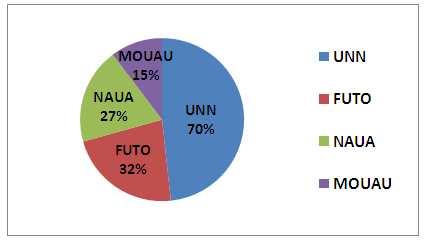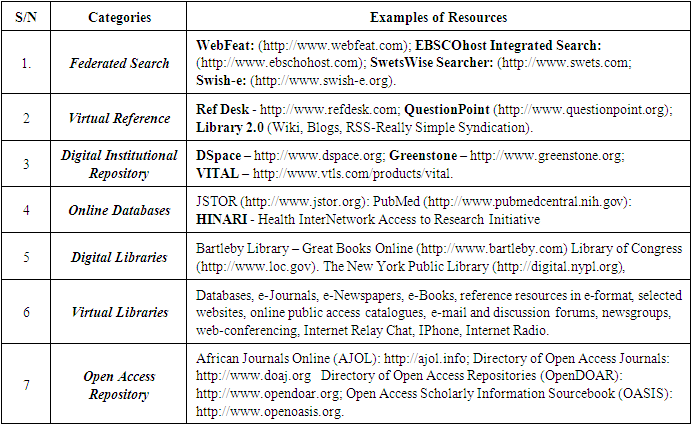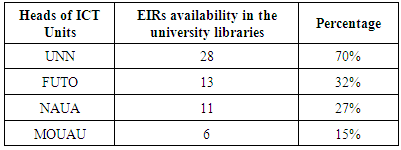-
Paper Information
- Paper Submission
-
Journal Information
- About This Journal
- Editorial Board
- Current Issue
- Archive
- Author Guidelines
- Contact Us
International Journal of Library Science
p-ISSN: 2168-488X e-ISSN: 2168-4901
2015; 4(1): 7-12
doi:10.5923/j.library.20150401.02
Categories, Availability and Awareness of Electronic Information Resources by Postgraduate Library Users in South East Nigerian Federal Universities
Chimah Jonathan N.1, Nwokocha Udo2
1Energy Research Centre Library, UNN
2Abia State University, Uturu
Correspondence to: Chimah Jonathan N., Energy Research Centre Library, UNN.
| Email: |  |
Copyright © 2015 Scientific & Academic Publishing. All Rights Reserved.
This paper is an empirical study of concepts and categories of electronic information resources (EIRs); how much of them are available in Nigerian Libraries especially in the South East federal universities. The research design adopted in this study is a descriptive survey. Two complementary instruments were used for collecting primary data; questionnaire and semi-structured interview. The sample size is 120 made up of 30 people comprising librarians/ICT unit heads and PG students were purposively selected for the study. Data collected were analyzed using percentages. 40 EIRs were identified, out of which University of Nigeria (UNN) has a total number of 28 (70%) of the total electronic information resources available in the universities. Federal University of Technology Owerri (FUTO) subscribed 13 (32%). Nnamdi Azikiwe University Awka (NAUA) has 11 (27%); while Michael Okpara University of Agriculture Umudike (MOUAU) has 6 (15%) of the e-resources in its university library. Though findings reveal that greater number 78 (65%) of postgraduate students from the various universities indicated that they were aware of the available EIRs; whereas the fewer number and percentage 42 (35%) respectively indicated their unawareness; recommendations which include: ICT Infrastructural development, active awareness programme for PG students and Electronic Information literacy programmes are made for improvement.
Keywords: Electronic Information Resources, EIRs Categories, Availability, Awareness, Postgraduate library users, Federal universities, Nigeria
Cite this paper: Chimah Jonathan N., Nwokocha Udo, Categories, Availability and Awareness of Electronic Information Resources by Postgraduate Library Users in South East Nigerian Federal Universities, International Journal of Library Science, Vol. 4 No. 1, 2015, pp. 7-12. doi: 10.5923/j.library.20150401.02.
Article Outline
1. Introduction
- The opportunity brought about by electronic information sources has in recent years exerted pressure on educational institutions and their libraries. The pressure on the institutions is the provision of the necessary infrastructure and the actual access to these sources. The pressure on the library and information centres is in the sourcing, acquisition and repackaging of these sources; as well as the provision of necessary guidance to end users. Libraries all over the world make available a wide variety of electronic information sources for use by the undergraduates, postgraduates, researchers and staff in their respective institutions. These e-resources form an essential part of the reference services provided by the university libraries. But provision is only part of the equation; resources must be utilized by staff and students at undergraduate and postgraduate levels. Postgraduate education (or graduate education in North America) involves learning and studying for degrees or other qualifications for which a first or Bachelor's degree generally is required, and is normally considered to be part of higher education. University library is defined by Reitz [1] as “a library or library system established, administered, and funded by a university to meet the information, research, and curriculum needs of its students, faculty, and staff. Some large universities maintain separate undergraduate and graduate libraries.”
1.1. Objectives of the Study
- The general purpose of this study is to investigate the categories and availability of electronic information resources and the level of their awareness by postgraduate library users in the Federal University Libraries in South East Nigeria. It has the following specific objectives:i. To determine the availability of electronic information resources in the university libraries under study. ii. To ascertain the level of awareness of available electronic information resources by postgraduate students in their institution libraries
1.2. Significance and Justification of the Study
- In Nigeria, just like other developing countries information technology application in libraries and information centres is not quite familiarized unlike advanced countries where it had long become a commonplace. Though there are a lot of theoretical emphasis and consciousness among information professionals including librarians regarding new trends in information technology vis-à-vis their application in the library and information services; however, actual practice is still lacking in some Nigerian universities. Consequently academic librarians and information scientists must, a matter of necessity acquaint themselves with electronic information resources so as to recommend for their procurement (if they are not available) for their universities or colleges and/or inform and guide library users to access and utilize them (if the e-resources are available) in their various institutions. Reason for selecting the four federal universities is because this study has not been conducted in this geopolitical zone of Nigeria. Motivation and justification of this study, therefore, is based on the fact that the findings will show available electronic information resources in the selected universities as well as their awareness by postgraduate library users. It will also encourage academic library administrators to know their level of resourcefulness and be challenged to make update if their libraries are not adequately equipped to meet the information needs of the faculty and students who naturally depend on them for knowledge resources as they carry out their teaching, learning and research activities.
1.3. Research Questions
- Two research questions were formulated to guide the study:1: What electronic information resources are available in the University library?2: What is the level of postgraduate students’ awareness of Electronic Information Resources available in the university library?
2. Conceptual Framework (EIRs & Its Categories)
2.1. Electronic Information Resources
- Reitz [1] defined electronic resource as “material consisting of data and/or computer program (s) encoded for reading and manipulation by a computer, by the use of a peripheral device directly connected to the computer, such as a CD-ROM drive, or remotely via a network, such as the Internet.” According to her the category includes software applications, electronic texts, bibliographic databases, institutional repositories, websites, e-books, collections of e-journals, etc. Electronic resources not publicly available free of charge usually require licensing and authentication. Electronic Resources are resources that can be accessed electronically via the Internet or digital media. Electronic resources according to California State University (CSU), [2] encompasses electronic databases, both full text and abstract/citation; e-journals, both individual and collections; e-books; e-article delivery services; etc. E-resources can be accessed remotely via the World Wide Web or delivered locally. Electronic Information Resources may be defined as information resources that are available and can be accessed electronically through such computer networked facilities as online library catalogues, the Internet and the World Wide Web, digital libraries and archives, government portals and websites, CD-ROM databases, online academic databases, such as Medline or Commercial databases such as LexisNexis as noted by Ekwelem, Okafor and Ukwoma [3].
2.2. Categories of Electronic Information Resources
- Joseph [4] identified some categories of electronic information resources as follows:(A) Federated Search – Federated search as a technology came into existence as a result of the desire by database and electronic resource subscribers to search and retrieve resources from multiple and disparate sources on a single interface. (B) Virtual Reference – Virtual reference service refers to the remote delivery of reference sources and resources to users who are not inside the library physically. This service includes; Knowledge base, Online chats, Text Messaging, and Co-browsing. (C) Digital Institutional Repository – Craw [5] defined institutional repositories as the “digital collections capturing and preserving the intellectual output of a single or multi-university community (which) provide a compelling response to two strategic issues facing academic institutions.” Joseph [4] on the other hand explains that “this is an online, searchable, web-accessible database containing intellectual works by scholars and researchers organized to increase access to scholarship and ensure their long term preservation. (D) Online Databases – JSTOR (http://www.jstor.org): Journal Storage is a United States-based online system for archiving academic journals, providing full-text searches of digitized back issues of several hundred well-known journals. (E) Digital Libraries – A digital library may be perceived as an information service or a collection of electronic information resources, in which all the information resources are available in computer processable form. Mutula and Ojedokun [6] identified several examples of digital libraries to include; Bartleby Library – Great Books Online (http://www.bartleby.com), Library of Congress (http://www.loc.gov) The New York Public Library (http://digital.nypl.org), (F) Virtual Libraries – Virtual library refers to an information service or collection of electronic resources whose collections are entirely in virtual or digital form and information is accessed over a network. Such a library provides access to virtual indexes, catalogues, and books. (Mutula and Ojedokun [6] a virtual library does not have physical space, where users visit to access information resources.(G) Open Access Repository – Open access is interested in the free availability of scholarly outputs on the Internet granting the user to make legal and non commercial use of the document and at the same time acknowledging the intellectual ownership of the author of the document. Researchers’ summary of EIRs categories are presented in table 1.
|
3. Research Method
- The research design adopted in this study is a descriptive survey. This method is considered appropriate because of its flexibility which permits the use of a variety of data collecting techniques such as questionnaire, interview and observation. Uhegbu [7] notes that “survey research is mainly an examination of current practices or approaches relating to an aspect of a social system and an attempt to relate certain results to particular cause, with a view to making effective moves for future improvement”.Two complementary instruments were used for collecting primary data; questionnaire and semi-structured interview of Heads of ICT Unit of the university libraries. The questionnaire for heads of ICT units was open-ended because they were required to indicate electronic information resources available in their libraries; while the questionnaire for postgraduate students were designed to ascertain their awareness of the existing EIRs in their university libraries. Sample size is 120 made up of 30 respondents from each university comprising librarians/ICT unit heads and PG students were purposively selected for the study.The questionnaire items were distributed personally by the researcher by visiting postgraduate students in their PG Schools, classrooms, hostels and digital libraries of their universities. They were collected by the researchers to ensure maximum return and correctness. Data collected were analyzed using percentages. Table 2 shows electronic information resources (EIRs) available in the universities surveyed.
4. Results and Discussion
- Research Question 1: What electronic information resources are available in the University library?Table 2 shows the availability and non-availability of electronic information resources in the four universities understudy. The University of Nigeria, Nsukka library has twenty eight (28) types. Federal University of Technology, Owerri library provided thirteen (13) types. Nnamdi Azikiwe University, Awka library makes available eleven (11) types. And Michael Okpara University of Agriculture, Umudike library subscribes to six (6) types of electronic information resources.
|
- The above data is summarized in the table 3.
|
 | Figure 1. EIRs Availability in the Universities under study |
|
4.1. Summary of Findings
4.1.1. Availability of Electronic Information Resources
- The finding shows that one of the Universities (University of Nigeria Nsukka) has most of the electronic information resources investigated in this study. The figures and percentages are as follows: UNN – 28 (70%); FUTO – 13 (32%); NAUA – 11 (27%); and MOUAU – 6 (15%). Generally, the data shows that while UNN has most of the electronic information resources, other universities have just few of them. However, the interview with head of ICT Unit at UNN shows that most of the EIRs of University of Nigeria Nsukka are available at the Digital Library of the university being co-sponsored by Mobile Telephone Network (MTN) and UNN.The study has clearly confirmed the availability of e-journals, e-books, etc., through the digital library for academic staff’s and research student’s use. This may be due to the policy of the universities to drive all their activities with information and communication facilities. This corroborates Mutula and Ojedokun’s [7] view that highlighted databases, e-journals, e-newspapers, e-books, e-mail and Internet facilities as information resources available through e-library.
4.2.2. Awareness of Available e-resources
- Awareness of e-resources indicated user knowledge of the availability of the resources, their services and the extent of accessibility to the e-resources. Due to the fact that greater number 78 (65%) of postgraduate students from the various universities indicated that they were aware, whereas the fewer number and percentage 42 (35%) respectively indicated their unawareness; it therefore implies that most postgraduate students are aware of the electronic information resources available in their various university libraries.
4.3. Conclusion and Recommendations
- Several electronic information resources were identified and defined as well as indicated as being available in the libraries of the four federal universities in South-East Nigeria which include University of Nigeria Nsukka (UNN), Nnamdi Azikiwe University Awka (NAUA) Federal University of Technology Owerri (FUTO) and Michael Okpara University of Agriculture Umudike (MOUAU). Some postgraduate students are aware but others are not aware of the available e-resources. The study also reveals that awareness of the availability of electronic information resources services in the universities was not widespread among students and a significantly large percentage of students indicated they could not use EIRs in the universities due to either unawareness of their availability. Based on the findings the researcher recommends the followings: ● There should be development of ICT infrastructures and procurement of EIRs including library databases software by University librarians.● In the same vein librarians should adopt an active awareness programme and student-centred approach in their acquisition as intervention measures for improving availability and students’ skills in using EIRs.●Information literacy programmes, seminars and workshops and other innovative strategies like developing online tutorials should be incorporated into postgraduate curriculum.
 Abstract
Abstract Reference
Reference Full-Text PDF
Full-Text PDF Full-text HTML
Full-text HTML


